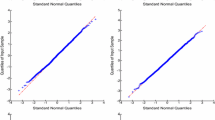Abstract
Additive hazards model is often used to complement the proportional hazards model in the analysis of failure time data. Statistical inference of additive hazards model with time-dependent longitudinal covariates requires the availability of the whole trajectory of the longitudinal process, which is not realistic in practice. The commonly used last value carried forward approach for intermittently observed longitudinal covariates can induce biased parameter estimation. The more principled joint modeling of the longitudinal process and failure time data imposes strong modeling assumptions, which is difficult to verify. In this paper, we propose methods that weigh the distance between the observational time of longitudinal covariates and the failure time, resulting in unbiased regression coefficient estimation. We establish the consistency and asymptotic normality of the proposed estimators. Simulation studies provide numerical support for the theoretical findings. Data from an Alzheimer’s study illustrate the practical utility of the methodology.
Similar content being viewed by others
References
Aalen OO (1989) A linear regression model for the analysis of life times. Statist Med 8:907–925
Andersen and Liestol (2003) Attenuation caused by infrequently updated covariates in survival analysis. Biostatistics 4:633–649
Buckley J, James I (1979) Linear regression with censored data. Biometrika 66:429–436
Bennett DA, Schneider JA, Buchman AS, Barnes LL, Boyle PA, Wilson RS (2012) Overview and findings from the rush memory and aging project. Current Alzheimer Res 9:646–663
Cao H, Churpek MM, Zeng D, Fine JP (2015) Analysis of the proportional hazards model with sparse longitudinal covariates. J Am Statist Assoc 110:1187–1196
Cao H, Zeng D, Fine JP (2015) Regression analysis of sparse asynchronous longitudinal data. J Royal Statist Soc: Ser B 77:755–776
Cao H, Fine JP (2021) On the proportional hazards model with last value carried forward covariates. Ann Inst Stat Math 73:115–134
Chen L, Cao H (2017) Analysis of asynchronous longitudinal data with partially linear models. Electron J Statist 11:1549–1569
Fan J, Gijbels I (1996) Local polynomial modeling and its applications. Chapman and Hall, London
Heitjan D, Rubin D (1991) Ignorability and coarse data. Annals of Statistist 19:2244–2253
Henderson R, Diggle P, Dobson A (2000) Joint modelling of longitudinal measurements and event time data. Biostatistics 1:465–480
Hogan JW, Laird NM (1997) Mixture models for the joint distribution of repeated measures and event times. Statist Med 16:239–257
Jiang J, Zhou Z (2007) Additive hazard regression with auxiliary covariates. Biometrika 94:359–369
Kenward MG, Molenberghs G (2009) Last observation carried forward: a crystal ball. J Biopharm Statist 19:872–888
Lachin JM (2016) Fallacies of last observation carried forward analyses. Clin Trials 13:161–168
Lin DY, Wei LJ (1989) The robust inference for the Cox proportional hazards model. J Am Statist Assoc 84:1074–1078
Lin DY, Ying Z (1994) Semiparametric analysis of the additive risk model. Biometrika 81:61–71
Lin DY, Ying Z (1995) Semiparametric analysis of general additive-multiplicative hazard models for counting processes. Annals Statist 23:1712–1734
Little RJA, Rubin DB (2002) Statistical analysis with missing data. Wiley, Hoboken
Martinussen T, Scheike TH (2002) A flexible additive multiplicative hazard model. Biometrika 89:283–298
Mckeague IW, Sasieni PD (1994) A partly parametric additive risk model. Biometrika 81:501–514
Rizopoulos D (2010) JM: an R package for the joint modeling of longitudinal and time-to-event data. J Statist Softw 35:1–33
Sharp ES, Gatz M (2011) The relationship between education and dementia an updated systematic review. Alzheimer Dis Assoc Disord 25:289–304
Struthers CA, Kalbfleisch JD (1986) Misspecified proportional hazard models. Biometrika 73:363–369
Tsiatis AA, Davidian M (2001) A semiparametric estimator for the proportional hazards model with longitudinal covariates measured with error. Biometrika 88:447–458
Wilson RS, Beck TL, Bienias JL, Bennett DA (2007) Terminal cognitive decline: accelerated loss of cognition in the last years of life. Psychosom Med 69:131–137
Acknowledgements
We are grateful to two anonymous reviewers for helpful comments.
Author information
Authors and Affiliations
Additional information
Publisher's Note
Springer Nature remains neutral with regard to jurisdictional claims in published maps and institutional affiliations.
Supplementary Information
Below is the link to the electronic supplementary material.
Rights and permissions
About this article
Cite this article
Sun, Z., Cao, H. & Chen, L. Regression analysis of additive hazards model with sparse longitudinal covariates. Lifetime Data Anal 28, 263–281 (2022). https://doi.org/10.1007/s10985-022-09548-6
Received:
Accepted:
Published:
Issue Date:
DOI: https://doi.org/10.1007/s10985-022-09548-6



